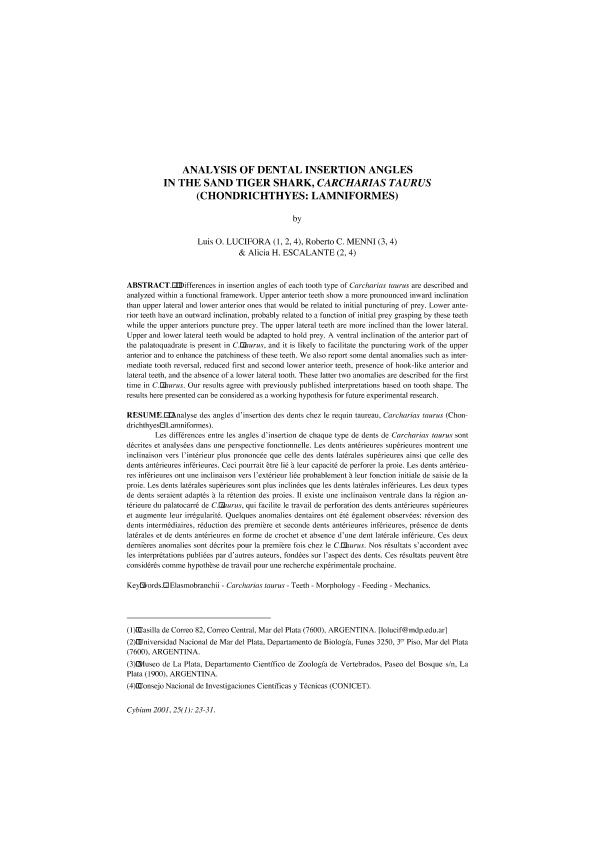Artículo
Differences in insertion angles of each tooth type of Carcharias taurus are described and analyzed within a functional framework. Upper anterior teeth show a more pronounced inward inclination than upper lateral and lower anterior ones that would be related to initial puncturing of prey. Lower anterior teeth have an outward inclination, probably related to a function of initial prey grasping by these teeth while the upper anteriors puncture prey. The upper lateral teeth are more inclined than the lower lateral. Upper and lower lateral teeth would be adapted to hold prey. A ventral inclination of the anterior part of the palatoquadrate is present in C. taurus, and it is likely to facilitate the puncturing work of the upper anterior and to enhance the patchiness of these teeth. We also report some dental anomalies such as intermediate tooth reversal, reduced first and second lower anterior teeth, presence of hook-like anterior and lateral teeth, and the absence of a lower lateral tooth. These latter two anomalies are described for the first time in C. taurus. Our results agree with previously published interpretations based on tooth shape. The results here presented can be considered as a working hypothesis for future experimental research. Les différences entre les angles d’insertion de chaque type de dents de Carcharias taurussontdécrites et analysées dans une perspective fonctionnelle. Les dents antérieures supérieures montrent uneinclinaison vers l’intérieur plus prononcée que celle des dents latérales supérieures ainsi que celle desdents antérieures inférieures. Ceci pourrait être lié à leur capacité de perforer la proie. Les dents antérieu-res inférieures ont une inclinaison vers l’extérieur liée probablement à leur fonction initiale de saisie de laproie. Les dents latérales supérieures sont plus inclinées que les dents latérales inférieures. Les deux typesde dents seraient adaptés à la rétention des proies. Il existe une inclinaison ventrale dans la région an-térieure du palatocarré de C.!taurus, qui facilite le travail de perforation des dents antérieures supérieureset augmente leur irrégularité. Quelques anomalies dentaires ont été également observées: réversion desdents intermédiaires, réduction des première et seconde dents antérieures inférieures, présence de dentslatérales et de dents antérieures en forme de crochet et absence d’une dent latérale inférieure. Ces deuxdernières anomalies sont décrites pour la première fois chez le C.!taurus. Nos résultats s’accordent avecles interprétations publiées par d’autres auteurs, fondées sur l’aspect des dents. Ces résultats peuvent êtreconsidérés comme hypothèse de travail pour une recherche expérimentale prochaine.
Analysis of dental insertion angles in the sand tiger shark, Charcharias taurus (Chondrichthyes: Lamniforms)
Fecha de publicación:
12/2001
Editorial:
French Ichthyological Society
Revista:
Cybium
ISSN:
0399-0974
Idioma:
Inglés
Tipo de recurso:
Artículo publicado
Clasificación temática:
Resumen
Palabras clave:
Carcharias taurus
,
Elasmobranchii
,
Feeding
,
Mechanics
,
Morphology
,
Teeth
Archivos asociados
Licencia
Identificadores
Colecciones
Articulos(IIMYC)
Articulos de INSTITUTO DE INVESTIGACIONES MARINAS Y COSTERAS
Articulos de INSTITUTO DE INVESTIGACIONES MARINAS Y COSTERAS
Citación
Lucifora, Luis Omar; Menni, Roberto Carlos; Escalante, Alicia Haydee; Analysis of dental insertion angles in the sand tiger shark, Charcharias taurus (Chondrichthyes: Lamniforms); French Ichthyological Society; Cybium; 25; 1; 12-2001; 23-31
Compartir




